MODERN ENGLISH LEXICOLOGY Phraseology. Set-expressions. Phraseology Phraseology (Gr.

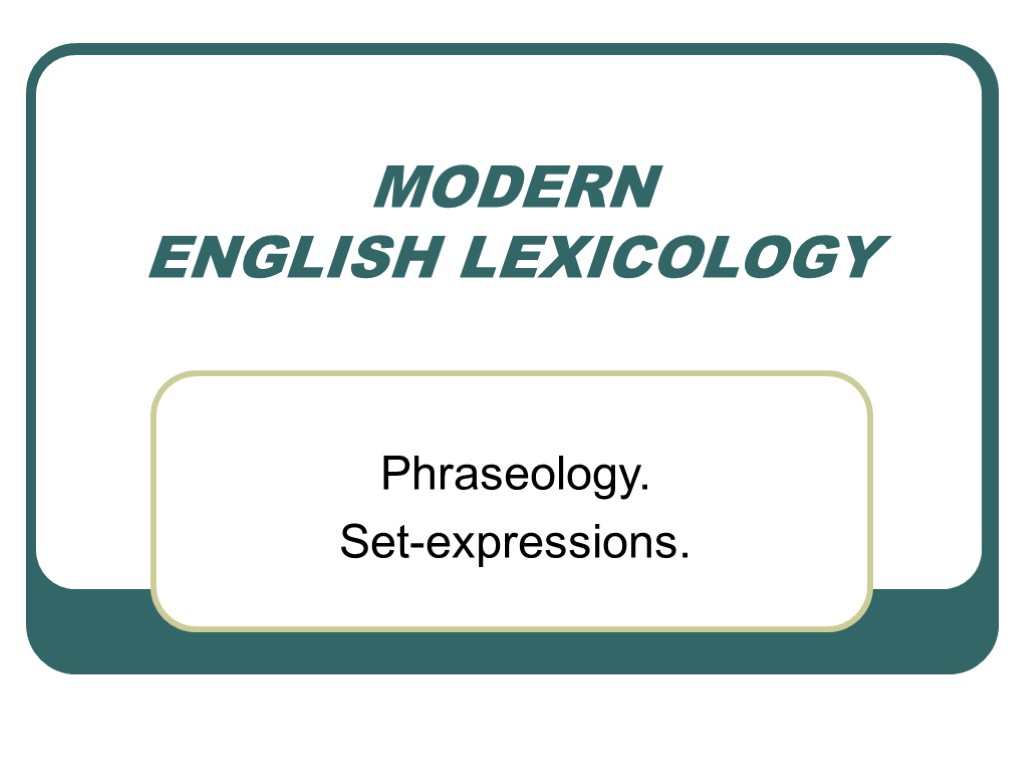
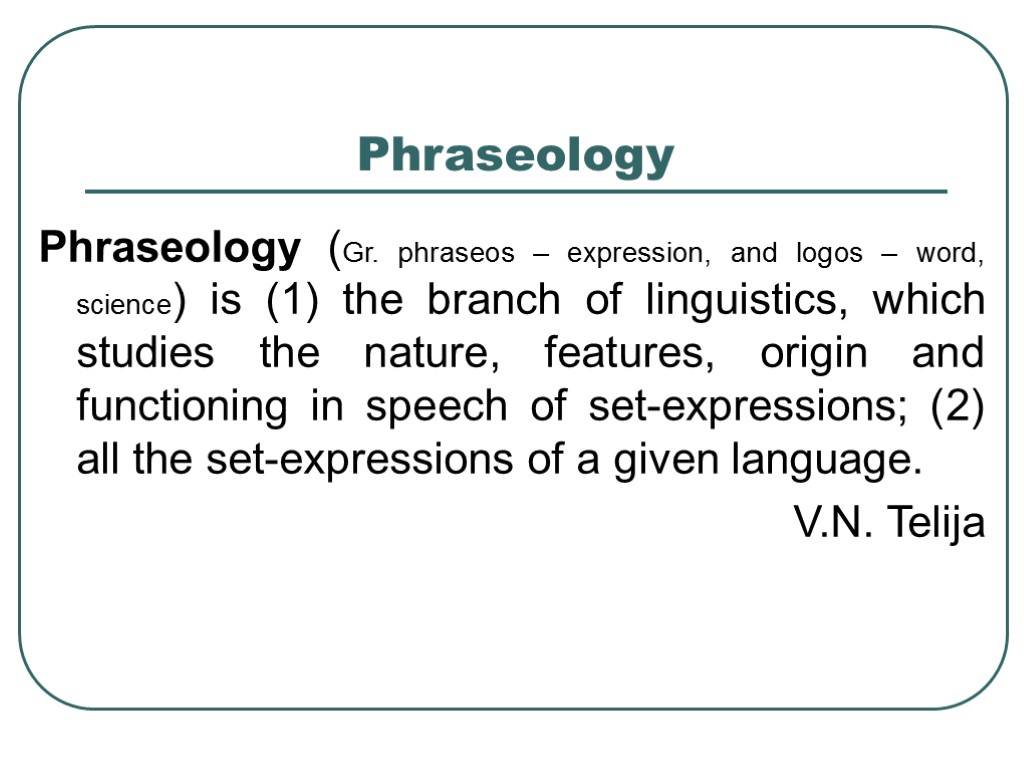
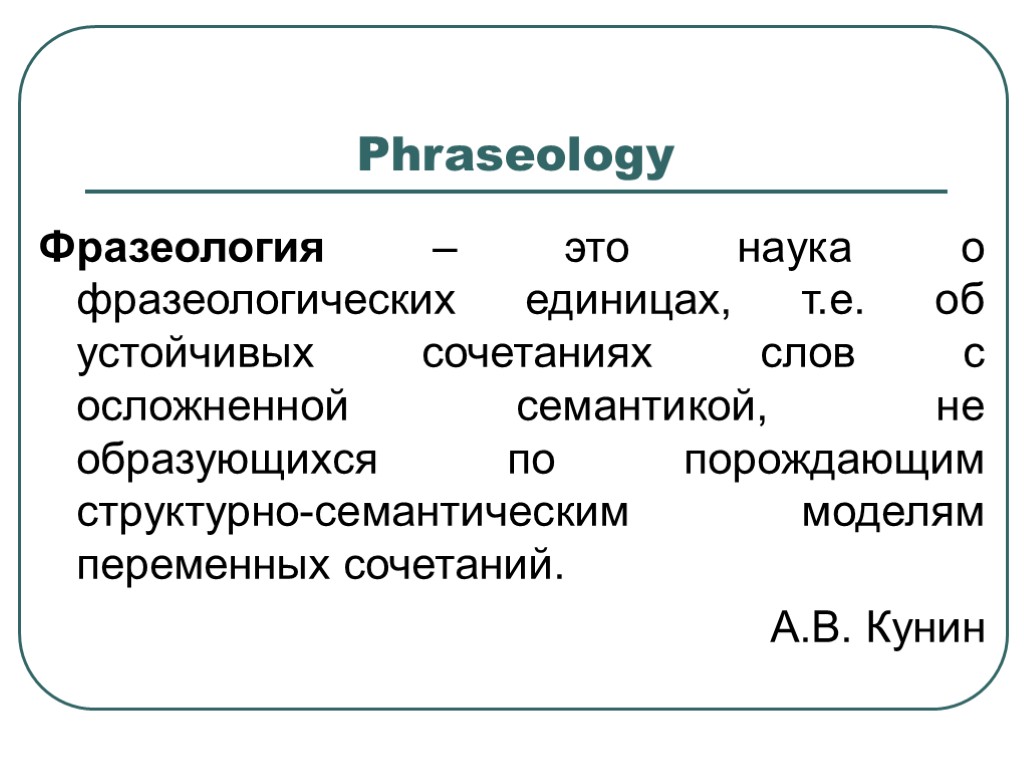
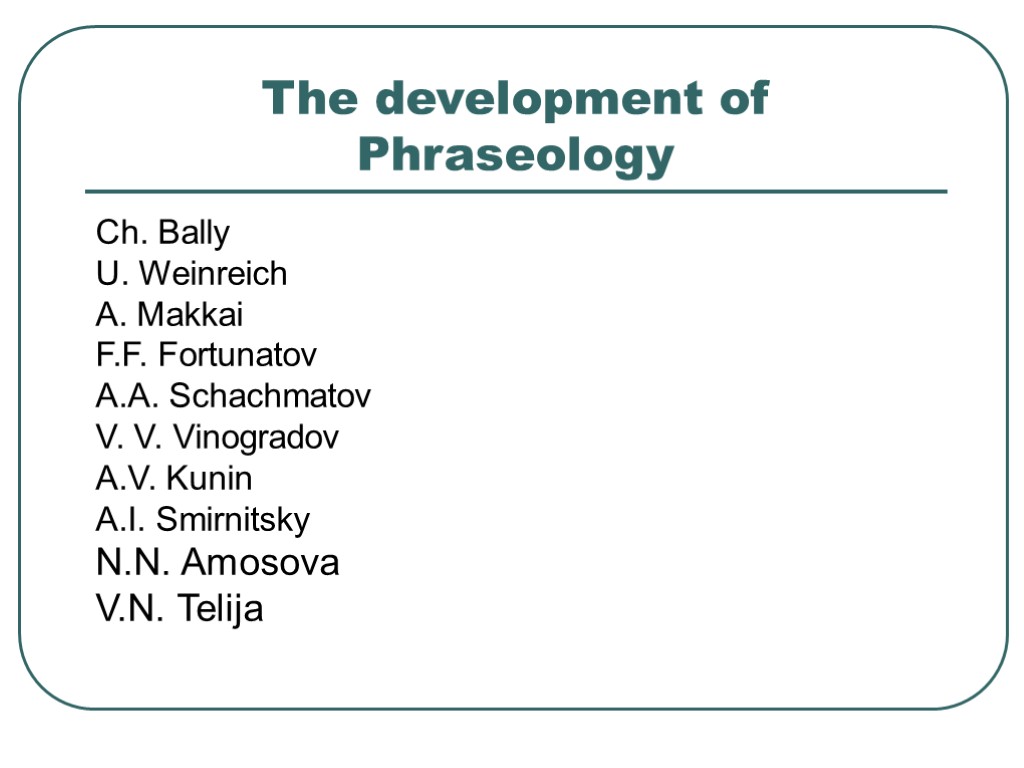
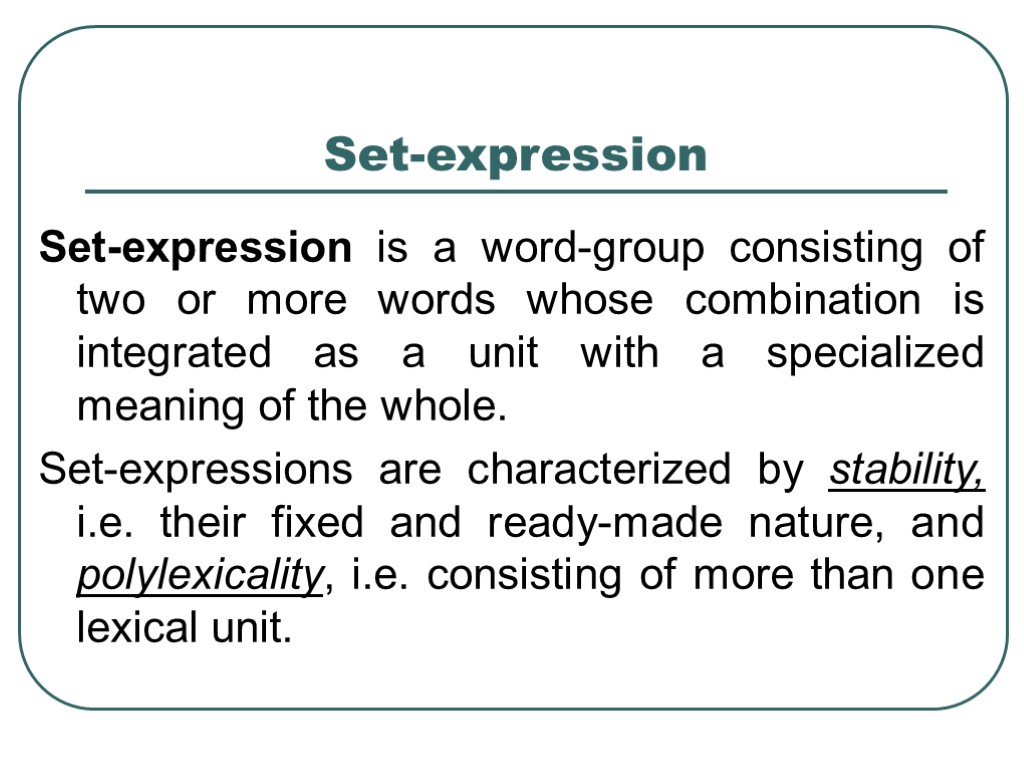
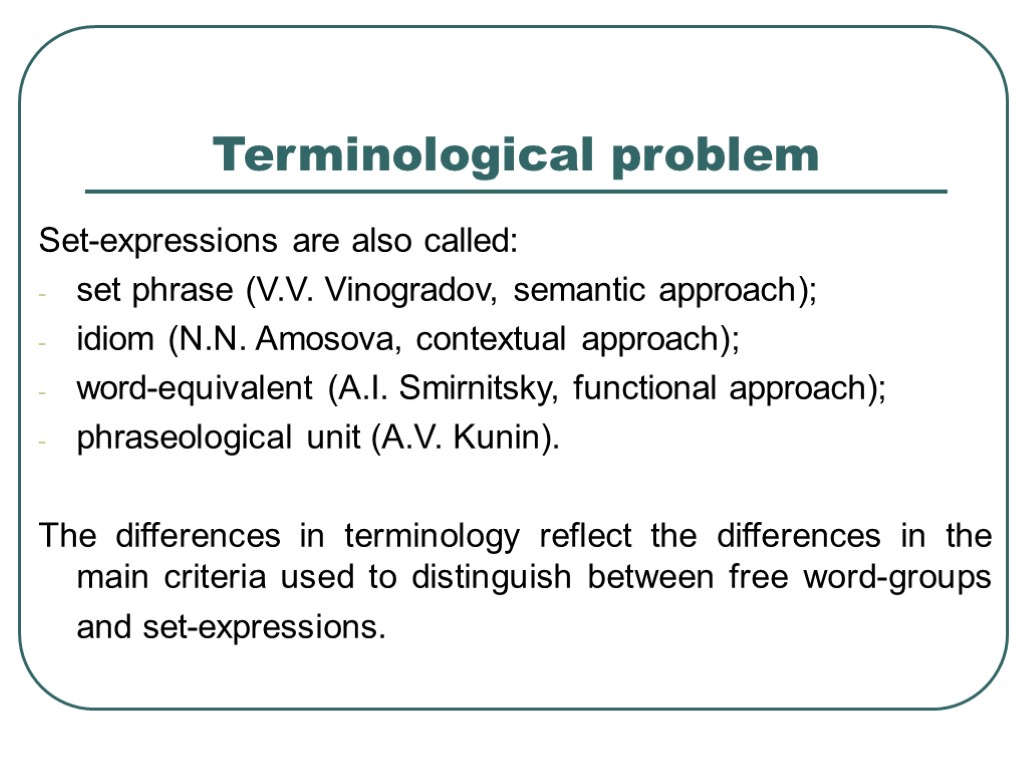
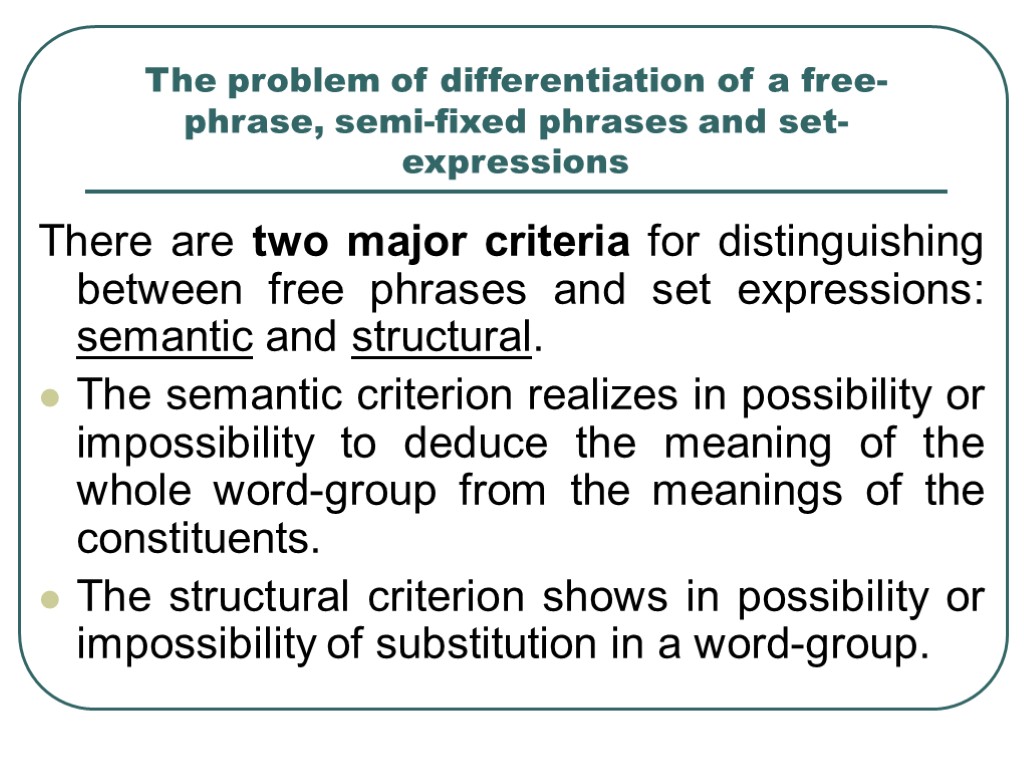
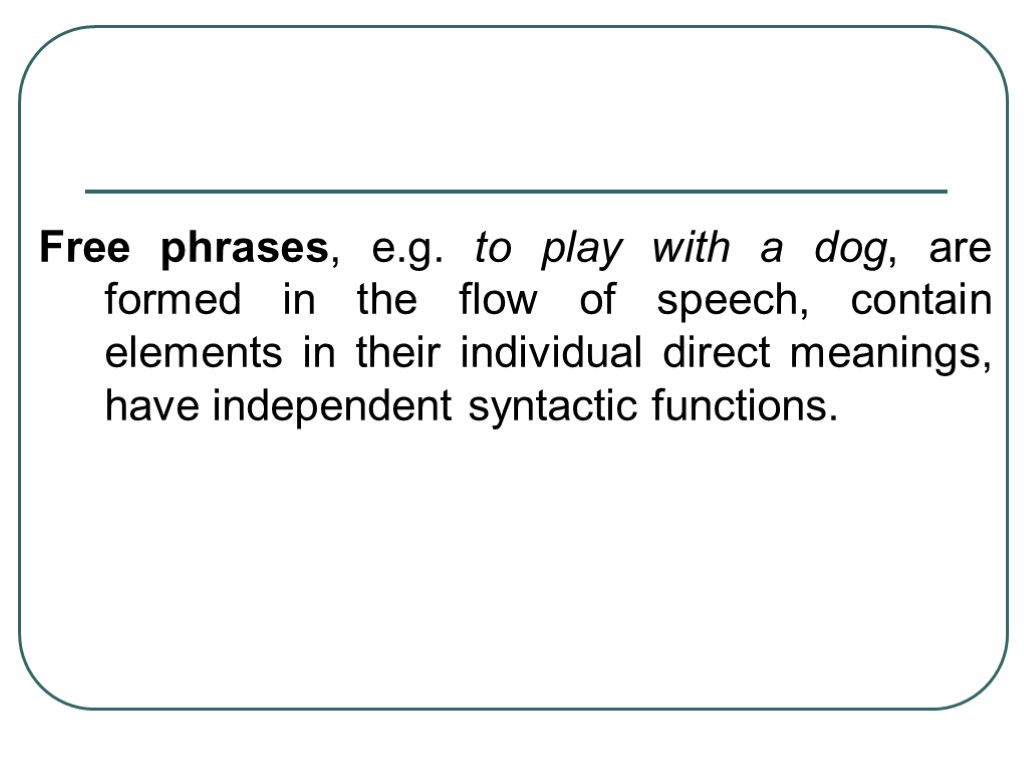
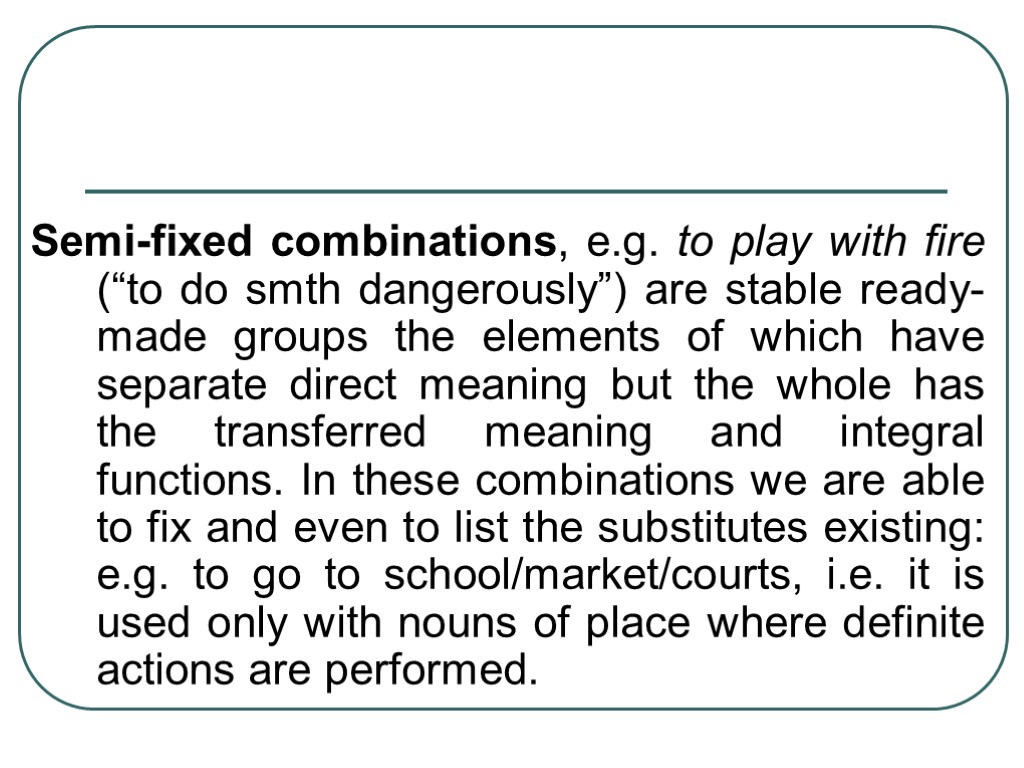
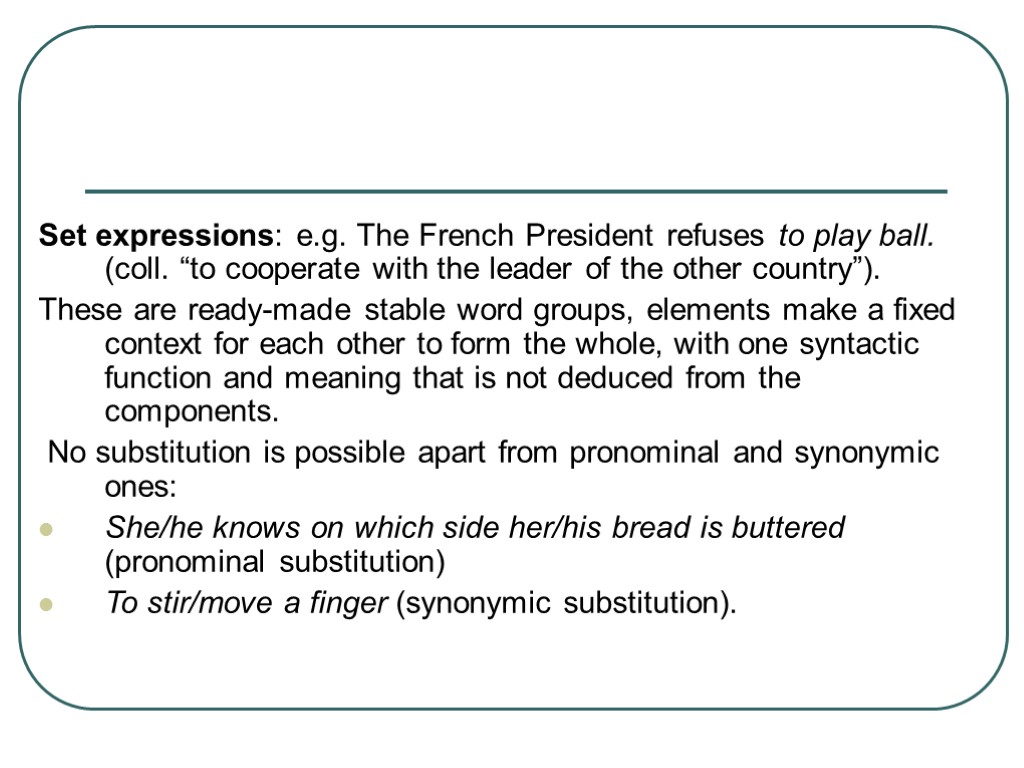
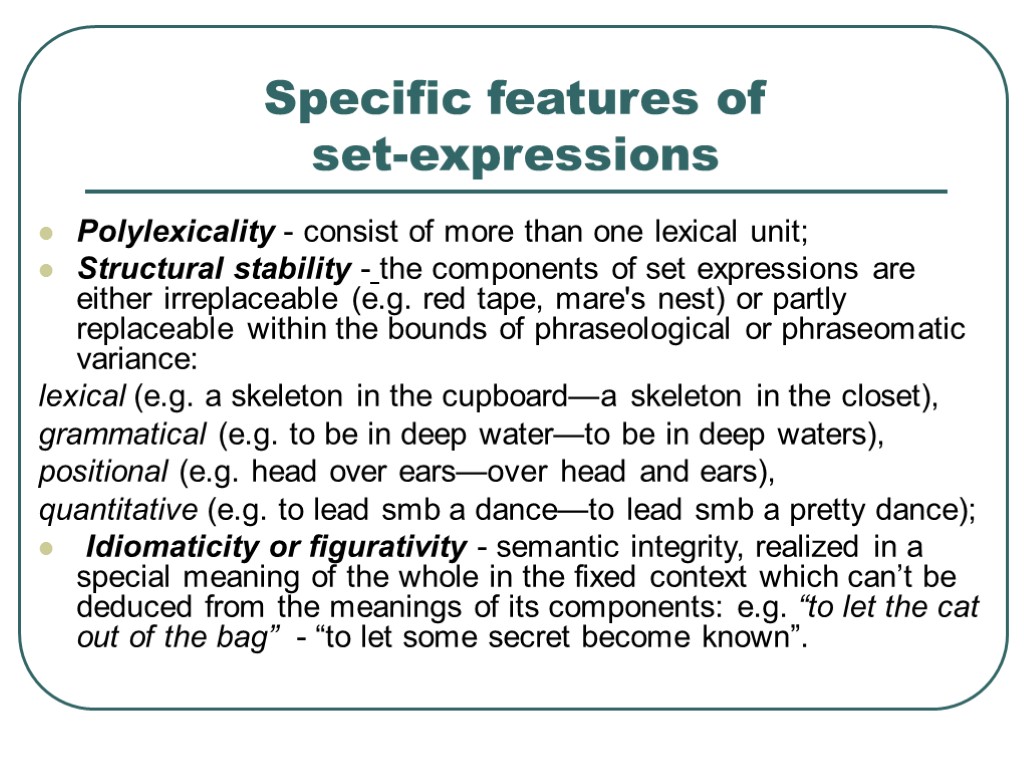
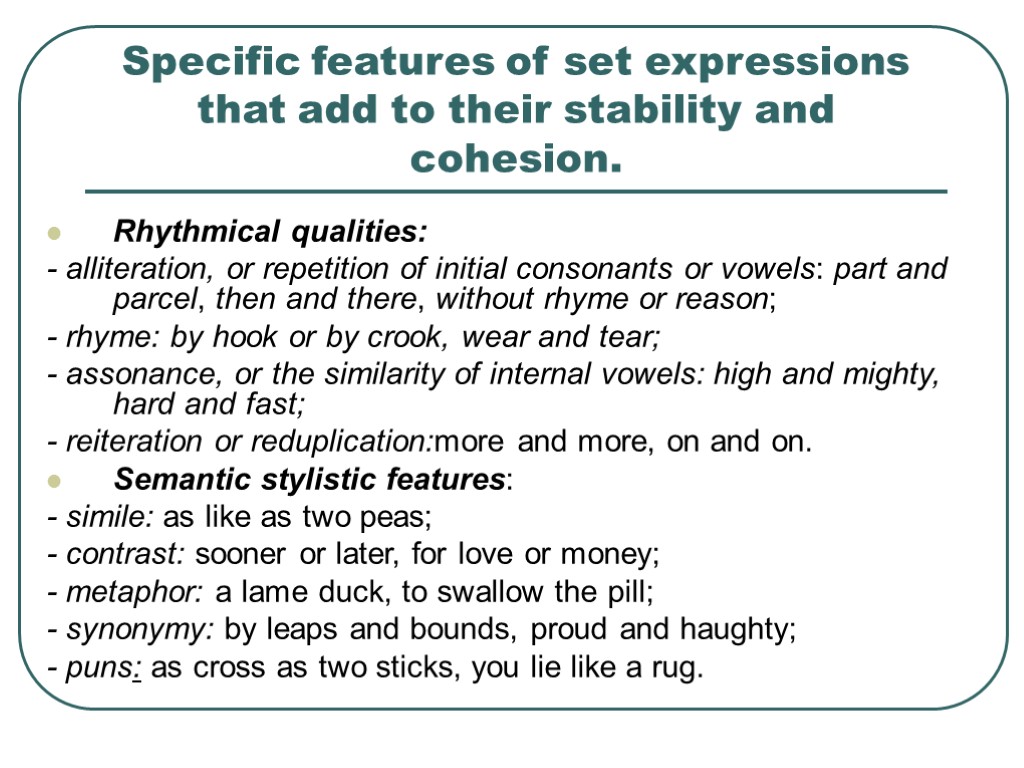
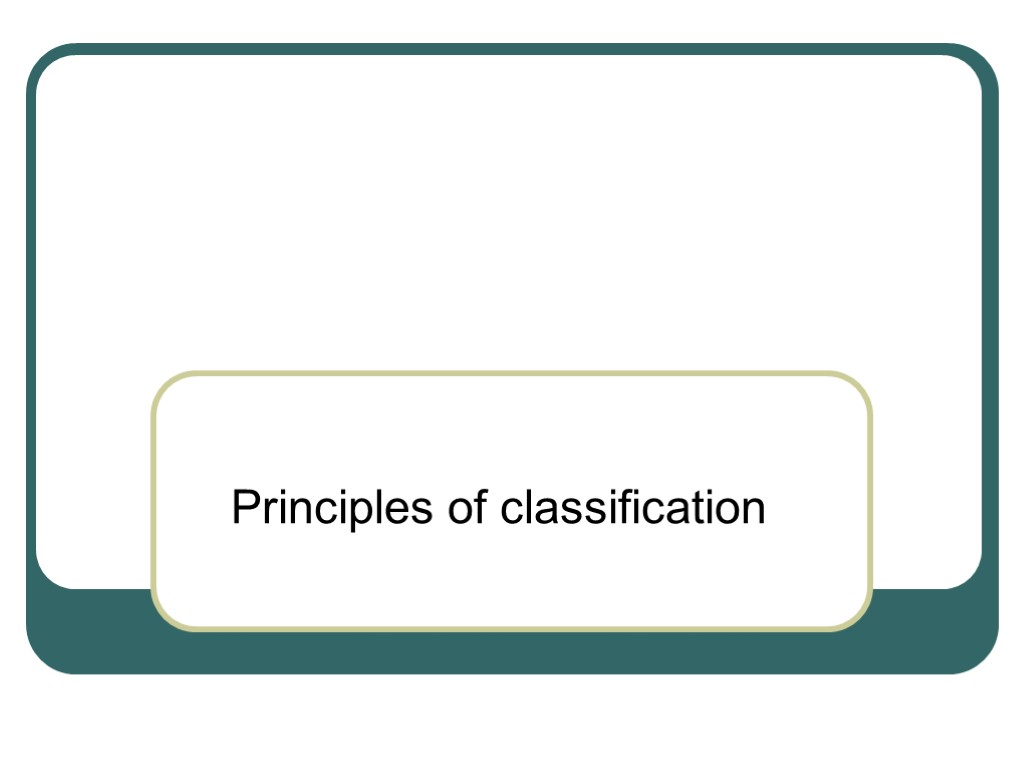
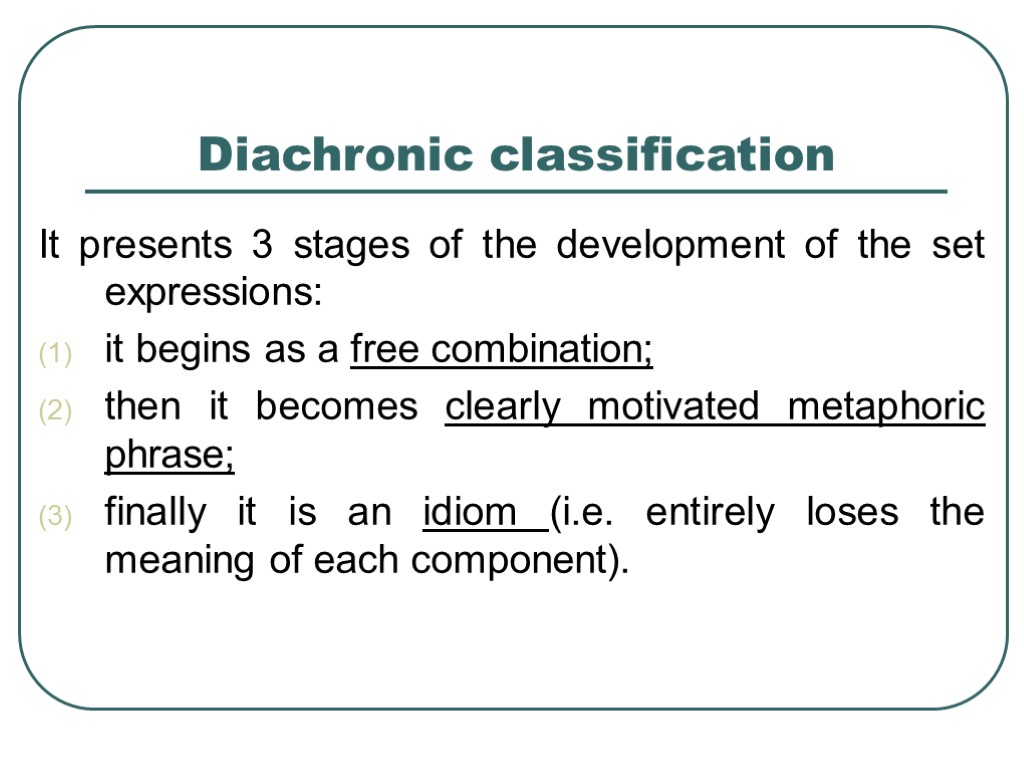
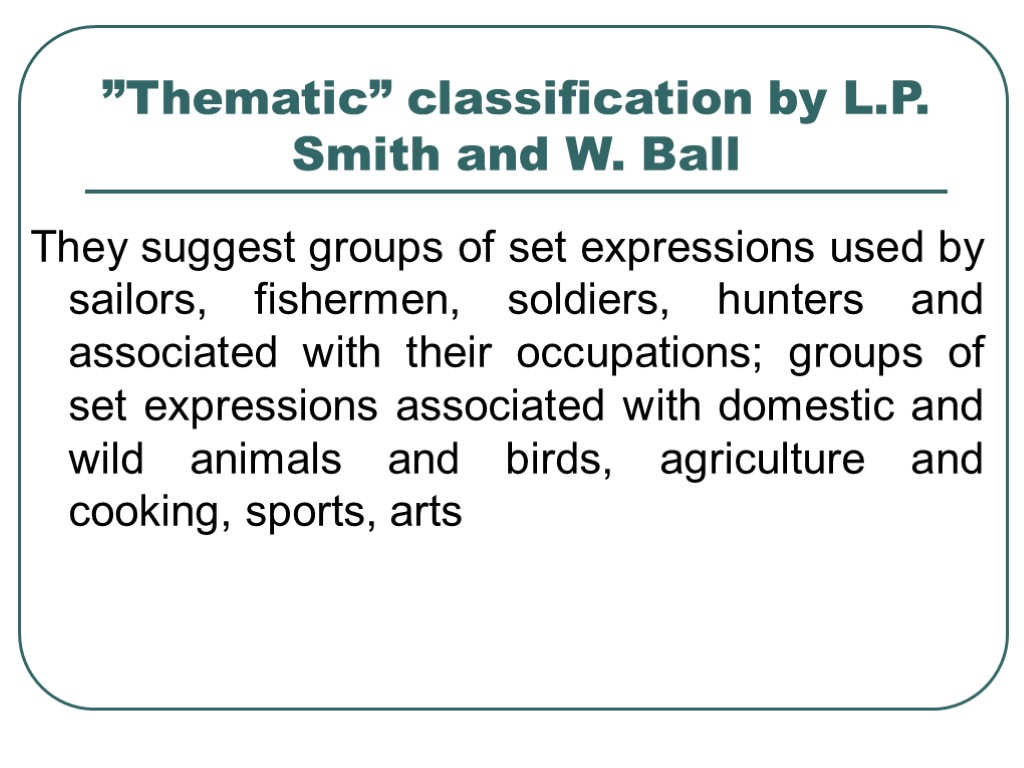
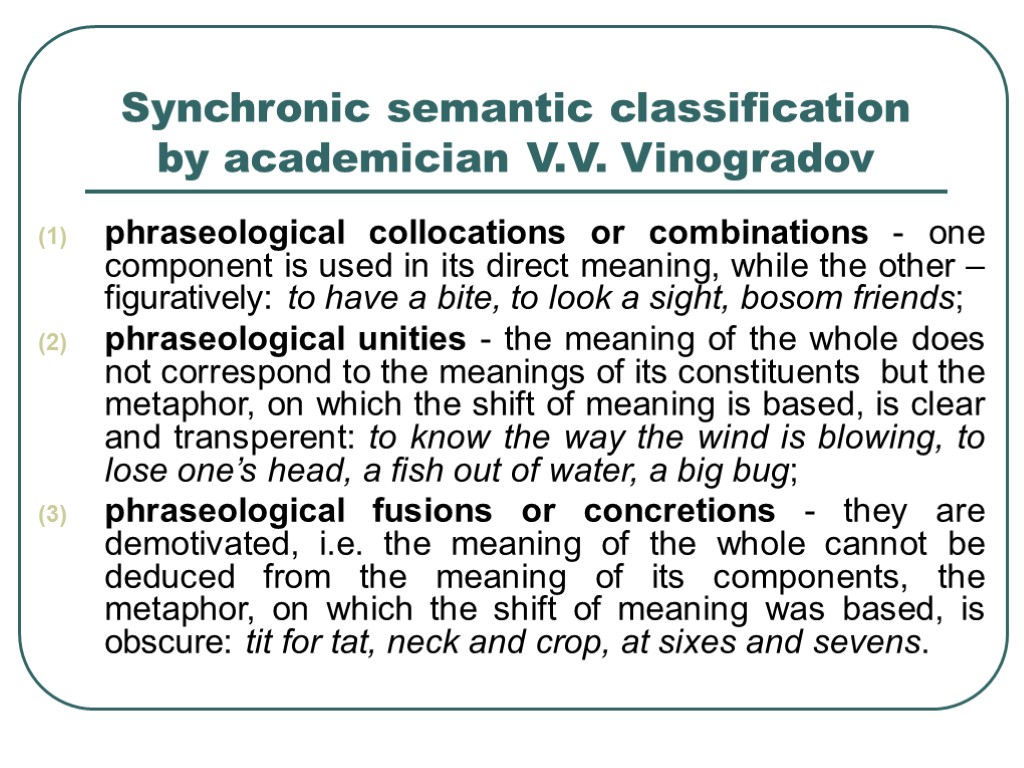
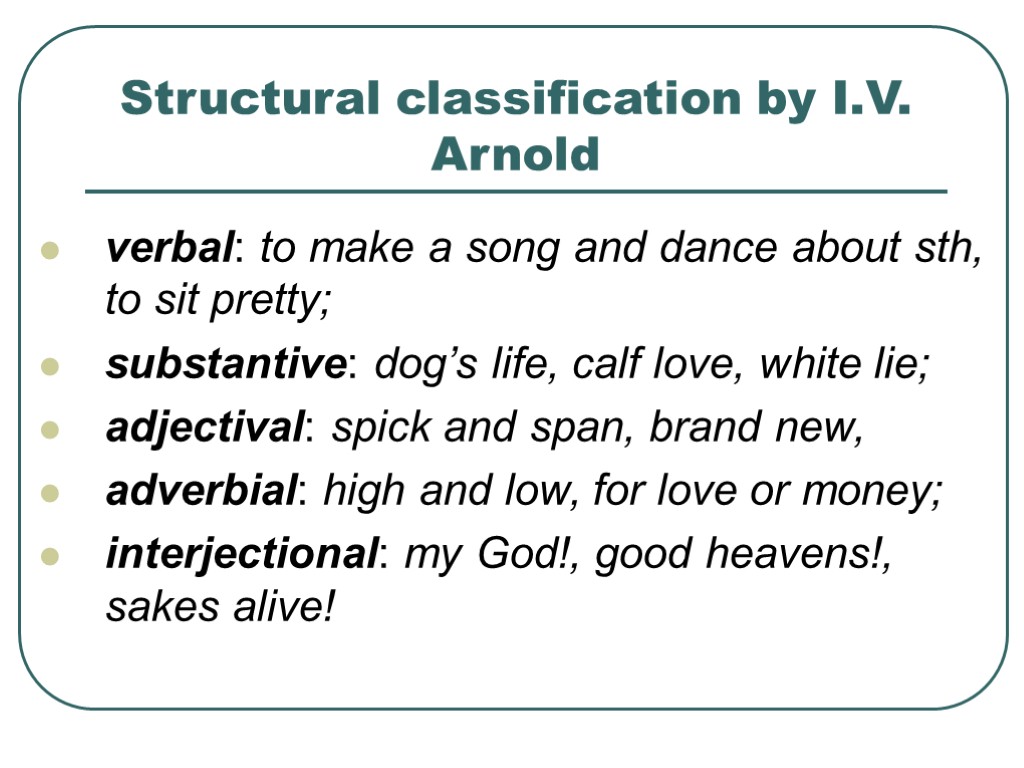
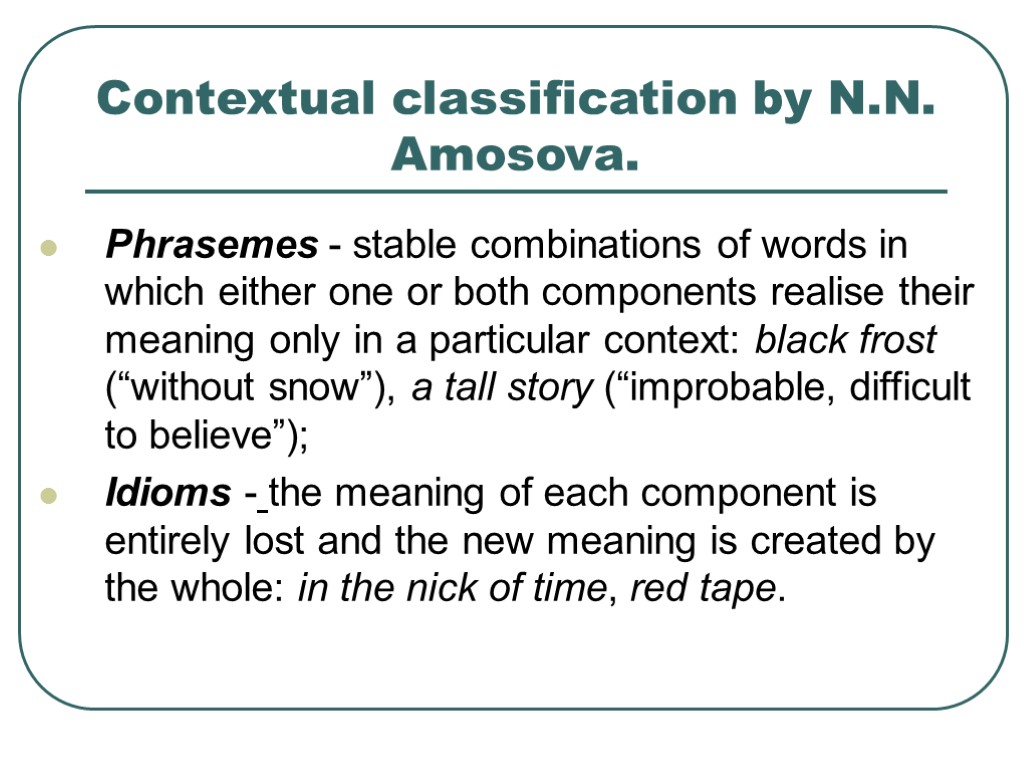
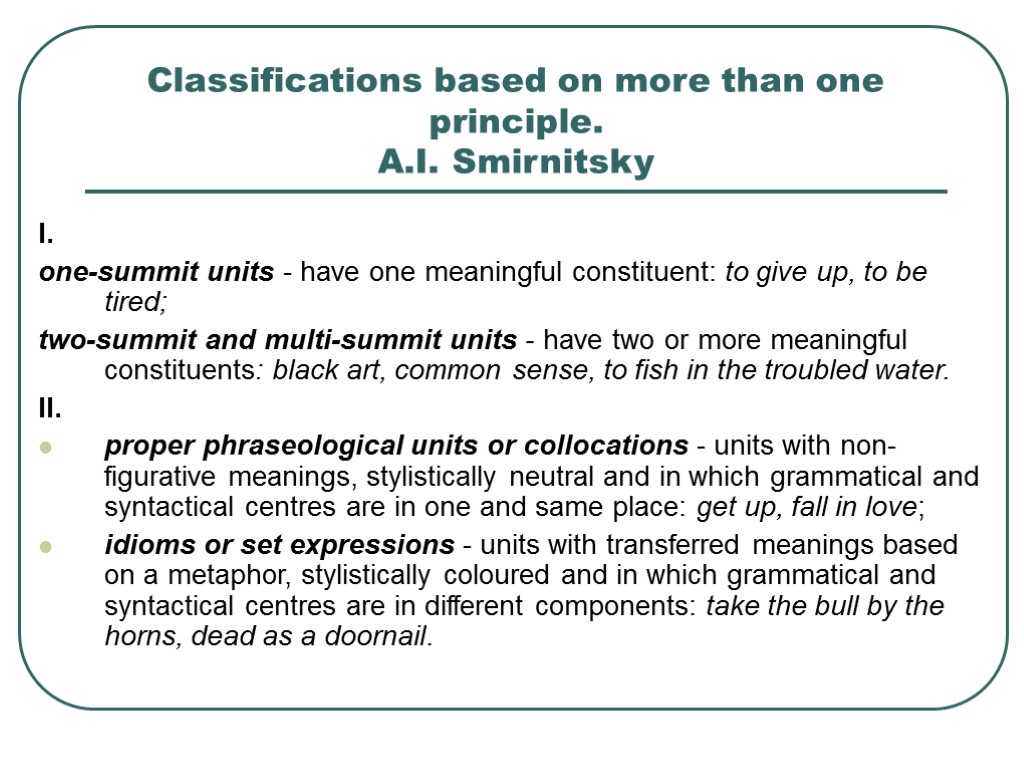
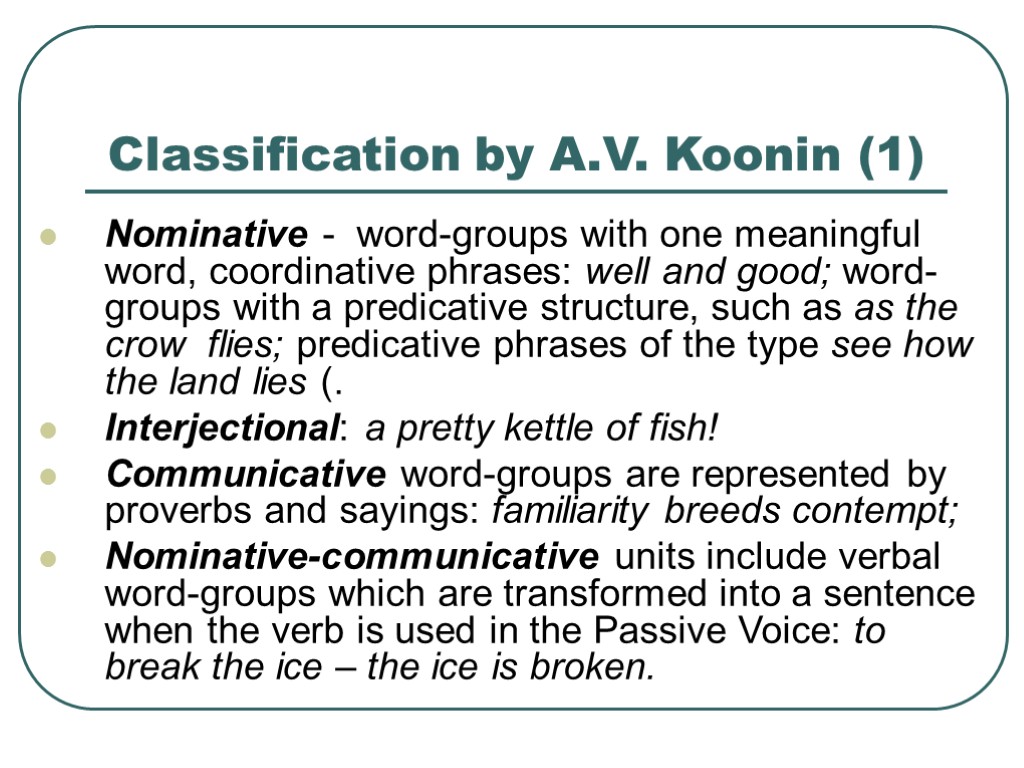
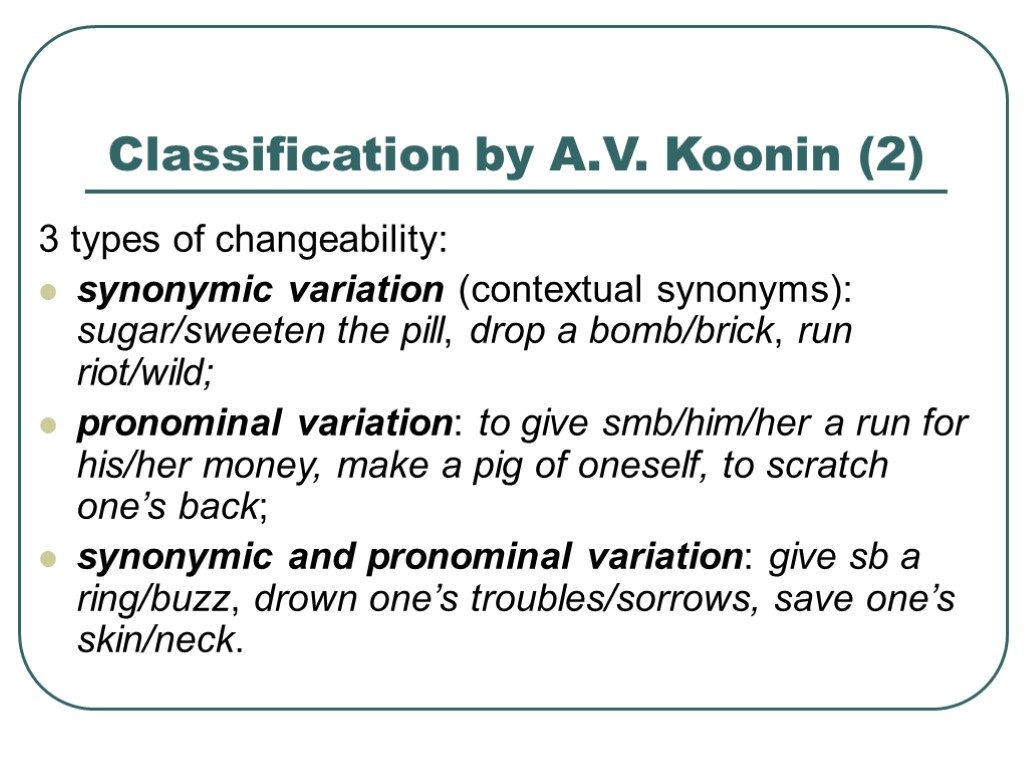
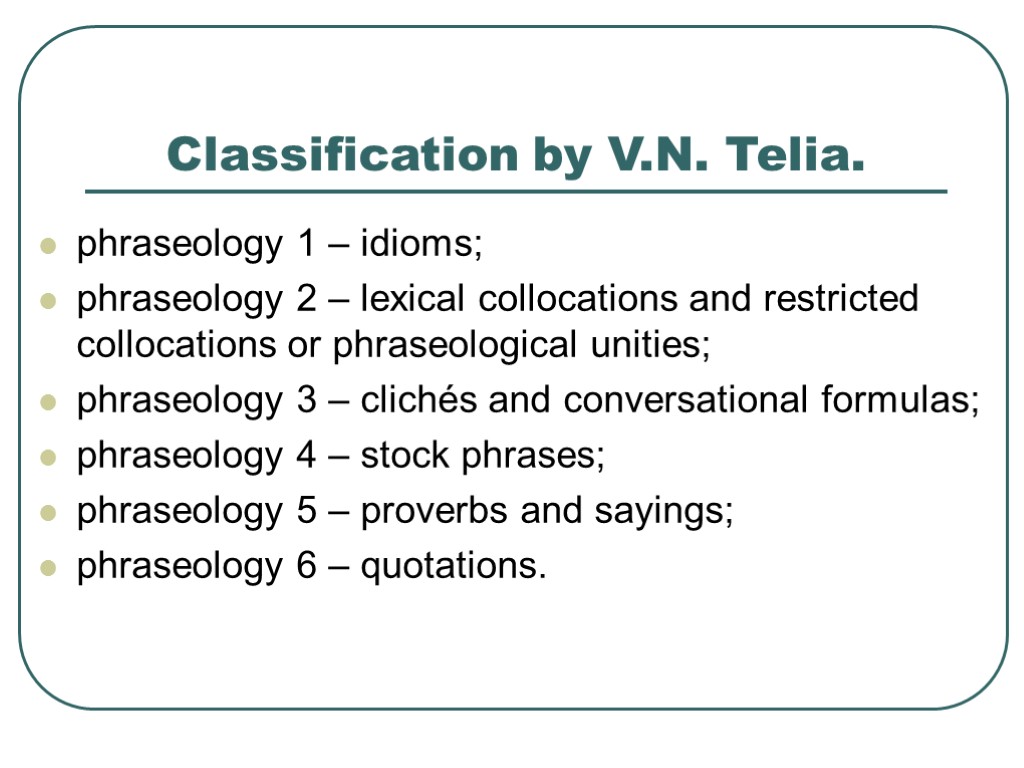
set-expressions.ppt
- Количество слайдов: 22
 MODERN ENGLISH LEXICOLOGY Phraseology. Set-expressions.
MODERN ENGLISH LEXICOLOGY Phraseology. Set-expressions.
 Phraseology Phraseology (Gr. phraseos – expression, and logos – word, science) is (1) the branch of linguistics, which studies the nature, features, origin and functioning in speech of set-expressions; (2) all the set-expressions of a given language. V.N. Telija
Phraseology Phraseology (Gr. phraseos – expression, and logos – word, science) is (1) the branch of linguistics, which studies the nature, features, origin and functioning in speech of set-expressions; (2) all the set-expressions of a given language. V.N. Telija
 Phraseology Фразеология – это наука о фразеологических единицах, т.е. об устойчивых сочетаниях слов с осложненной семантикой, не образующихся по порождающим структурно-семантическим моделям переменных сочетаний. А.В. Кунин
Phraseology Фразеология – это наука о фразеологических единицах, т.е. об устойчивых сочетаниях слов с осложненной семантикой, не образующихся по порождающим структурно-семантическим моделям переменных сочетаний. А.В. Кунин
 The development of Phraseology Ch. Bally U. Weinreich A. Makkai F.F. Fortunatov A.A. Schachmatov V. V. Vinogradov A.V. Kunin A.I. Smirnitsky N.N. Amosova V.N. Telija
The development of Phraseology Ch. Bally U. Weinreich A. Makkai F.F. Fortunatov A.A. Schachmatov V. V. Vinogradov A.V. Kunin A.I. Smirnitsky N.N. Amosova V.N. Telija
 Set-expression Set-expression is a word-group consisting of two or more words whose combination is integrated as a unit with a specialized meaning of the whole. Set-expressions are characterized by stability, i.e. their fixed and ready-made nature, and polylexicality, i.e. consisting of more than one lexical unit.
Set-expression Set-expression is a word-group consisting of two or more words whose combination is integrated as a unit with a specialized meaning of the whole. Set-expressions are characterized by stability, i.e. their fixed and ready-made nature, and polylexicality, i.e. consisting of more than one lexical unit.
 Terminological problem Set-expressions are also called: set phrase (V.V. Vinogradov, semantic approach); idiom (N.N. Amosova, contextual approach); word-equivalent (A.I. Smirnitsky, functional approach); phraseological unit (A.V. Kunin). The differences in terminology reflect the differences in the main criteria used to distinguish between free word-groups and set-expressions.
Terminological problem Set-expressions are also called: set phrase (V.V. Vinogradov, semantic approach); idiom (N.N. Amosova, contextual approach); word-equivalent (A.I. Smirnitsky, functional approach); phraseological unit (A.V. Kunin). The differences in terminology reflect the differences in the main criteria used to distinguish between free word-groups and set-expressions.
 The problem of differentiation of a free-phrase, semi-fixed phrases and set-expressions There are two major criteria for distinguishing between free phrases and set expressions: semantic and structural. The semantic criterion realizes in possibility or impossibility to deduce the meaning of the whole word-group from the meanings of the constituents. The structural criterion shows in possibility or impossibility of substitution in a word-group.
The problem of differentiation of a free-phrase, semi-fixed phrases and set-expressions There are two major criteria for distinguishing between free phrases and set expressions: semantic and structural. The semantic criterion realizes in possibility or impossibility to deduce the meaning of the whole word-group from the meanings of the constituents. The structural criterion shows in possibility or impossibility of substitution in a word-group.
 Free phrases, e.g. to play with a dog, are formed in the flow of speech, contain elements in their individual direct meanings, have independent syntactic functions.
Free phrases, e.g. to play with a dog, are formed in the flow of speech, contain elements in their individual direct meanings, have independent syntactic functions.
 Semi-fixed combinations, e.g. to play with fire (“to do smth dangerously”) are stable ready-made groups the elements of which have separate direct meaning but the whole has the transferred meaning and integral functions. In these combinations we are able to fix and even to list the substitutes existing: e.g. to go to school/market/courts, i.e. it is used only with nouns of place where definite actions are performed.
Semi-fixed combinations, e.g. to play with fire (“to do smth dangerously”) are stable ready-made groups the elements of which have separate direct meaning but the whole has the transferred meaning and integral functions. In these combinations we are able to fix and even to list the substitutes existing: e.g. to go to school/market/courts, i.e. it is used only with nouns of place where definite actions are performed.
 Set expressions: e.g. The French President refuses to play ball. (coll. “to cooperate with the leader of the other country”). These are ready-made stable word groups, elements make a fixed context for each other to form the whole, with one syntactic function and meaning that is not deduced from the components. No substitution is possible apart from pronominal and synonymic ones: She/he knows on which side her/his bread is buttered (pronominal substitution) To stir/move a finger (synonymic substitution).
Set expressions: e.g. The French President refuses to play ball. (coll. “to cooperate with the leader of the other country”). These are ready-made stable word groups, elements make a fixed context for each other to form the whole, with one syntactic function and meaning that is not deduced from the components. No substitution is possible apart from pronominal and synonymic ones: She/he knows on which side her/his bread is buttered (pronominal substitution) To stir/move a finger (synonymic substitution).
 Specific features of set-expressions Polylexicality - consist of more than one lexical unit; Structural stability - the components of set expressions are either irreplaceable (e.g. red tape, mare's nest) or partly replaceable within the bounds of phraseological or phraseomatic variance: lexical (e.g. a skeleton in the cupboard—a skeleton in the closet), grammatical (e.g. to be in deep water—to be in deep waters), positional (e.g. head over ears—over head and ears), quantitative (e.g. to lead smb a dance—to lead smb a pretty dance); Idiomaticity or figurativity - semantic integrity, realized in a special meaning of the whole in the fixed context which can’t be deduced from the meanings of its components: e.g. “to let the cat out of the bag” - “to let some secret become known”.
Specific features of set-expressions Polylexicality - consist of more than one lexical unit; Structural stability - the components of set expressions are either irreplaceable (e.g. red tape, mare's nest) or partly replaceable within the bounds of phraseological or phraseomatic variance: lexical (e.g. a skeleton in the cupboard—a skeleton in the closet), grammatical (e.g. to be in deep water—to be in deep waters), positional (e.g. head over ears—over head and ears), quantitative (e.g. to lead smb a dance—to lead smb a pretty dance); Idiomaticity or figurativity - semantic integrity, realized in a special meaning of the whole in the fixed context which can’t be deduced from the meanings of its components: e.g. “to let the cat out of the bag” - “to let some secret become known”.
 Specific features of set expressions that add to their stability and cohesion. Rhythmical qualities: - alliteration, or repetition of initial consonants or vowels: part and parcel, then and there, without rhyme or reason; - rhyme: by hook or by crook, wear and tear; - assonance, or the similarity of internal vowels: high and mighty, hard and fast; - reiteration or reduplication:more and more, on and on. Semantic stylistic features: - simile: as like as two peas; - contrast: sooner or later, for love or money; - metaphor: a lame duck, to swallow the pill; - synonymy: by leaps and bounds, proud and haughty; - puns: as cross as two sticks, you lie like a rug.
Specific features of set expressions that add to their stability and cohesion. Rhythmical qualities: - alliteration, or repetition of initial consonants or vowels: part and parcel, then and there, without rhyme or reason; - rhyme: by hook or by crook, wear and tear; - assonance, or the similarity of internal vowels: high and mighty, hard and fast; - reiteration or reduplication:more and more, on and on. Semantic stylistic features: - simile: as like as two peas; - contrast: sooner or later, for love or money; - metaphor: a lame duck, to swallow the pill; - synonymy: by leaps and bounds, proud and haughty; - puns: as cross as two sticks, you lie like a rug.
 Principles of classification
Principles of classification
 Diachronic classification It presents 3 stages of the development of the set expressions: it begins as a free combination; then it becomes clearly motivated metaphoric phrase; finally it is an idiom (i.e. entirely loses the meaning of each component).
Diachronic classification It presents 3 stages of the development of the set expressions: it begins as a free combination; then it becomes clearly motivated metaphoric phrase; finally it is an idiom (i.e. entirely loses the meaning of each component).
 ”Thematic” classification by L.P. Smith and W. Ball They suggest groups of set expressions used by sailors, fishermen, soldiers, hunters and associated with their occupations; groups of set expressions associated with domestic and wild animals and birds, agriculture and cooking, sports, arts
”Thematic” classification by L.P. Smith and W. Ball They suggest groups of set expressions used by sailors, fishermen, soldiers, hunters and associated with their occupations; groups of set expressions associated with domestic and wild animals and birds, agriculture and cooking, sports, arts
 Synchronic semantic classification by academician V.V. Vinogradov phraseological collocations or combinations - one component is used in its direct meaning, while the other – figuratively: to have a bite, to look a sight, bosom friends; phraseological unities - the meaning of the whole does not correspond to the meanings of its constituents but the metaphor, on which the shift of meaning is based, is clear and transperent: to know the way the wind is blowing, to lose one’s head, a fish out of water, a big bug; phraseological fusions or concretions - they are demotivated, i.e. the meaning of the whole cannot be deduced from the meaning of its components, the metaphor, on which the shift of meaning was based, is obscure: tit for tat, neck and crop, at sixes and sevens.
Synchronic semantic classification by academician V.V. Vinogradov phraseological collocations or combinations - one component is used in its direct meaning, while the other – figuratively: to have a bite, to look a sight, bosom friends; phraseological unities - the meaning of the whole does not correspond to the meanings of its constituents but the metaphor, on which the shift of meaning is based, is clear and transperent: to know the way the wind is blowing, to lose one’s head, a fish out of water, a big bug; phraseological fusions or concretions - they are demotivated, i.e. the meaning of the whole cannot be deduced from the meaning of its components, the metaphor, on which the shift of meaning was based, is obscure: tit for tat, neck and crop, at sixes and sevens.
 Structural classification by I.V. Arnold verbal: to make a song and dance about sth, to sit pretty; substantive: dog’s life, calf love, white lie; adjectival: spick and span, brand new, adverbial: high and low, for love or money; interjectional: my God!, good heavens!, sakes alive!
Structural classification by I.V. Arnold verbal: to make a song and dance about sth, to sit pretty; substantive: dog’s life, calf love, white lie; adjectival: spick and span, brand new, adverbial: high and low, for love or money; interjectional: my God!, good heavens!, sakes alive!
 Contextual classification by N.N. Amosova. Phrasemes - stable combinations of words in which either one or both components realise their meaning only in a particular context: black frost (“without snow”), a tall story (“improbable, difficult to believe”); Idioms - the meaning of each component is entirely lost and the new meaning is created by the whole: in the nick of time, red tape.
Contextual classification by N.N. Amosova. Phrasemes - stable combinations of words in which either one or both components realise their meaning only in a particular context: black frost (“without snow”), a tall story (“improbable, difficult to believe”); Idioms - the meaning of each component is entirely lost and the new meaning is created by the whole: in the nick of time, red tape.
 Classifications based on more than one principle. A.I. Smirnitsky I. one-summit units - have one meaningful constituent: to give up, to be tired; two-summit and multi-summit units - have two or more meaningful constituents: black art, common sense, to fish in the troubled water. II. proper phraseological units or collocations - units with non-figurative meanings, stylistically neutral and in which grammatical and syntactical centres are in one and same place: get up, fall in love; idioms or set expressions - units with transferred meanings based on a metaphor, stylistically coloured and in which grammatical and syntactical centres are in different components: take the bull by the horns, dead as a doornail.
Classifications based on more than one principle. A.I. Smirnitsky I. one-summit units - have one meaningful constituent: to give up, to be tired; two-summit and multi-summit units - have two or more meaningful constituents: black art, common sense, to fish in the troubled water. II. proper phraseological units or collocations - units with non-figurative meanings, stylistically neutral and in which grammatical and syntactical centres are in one and same place: get up, fall in love; idioms or set expressions - units with transferred meanings based on a metaphor, stylistically coloured and in which grammatical and syntactical centres are in different components: take the bull by the horns, dead as a doornail.
 Classification by A.V. Koonin (1) Nominative - word-groups with one meaningful word, coordinative phrases: well and good; word-groups with a predicative structure, such as as the crow flies; predicative phrases of the type see how the land lies (. Interjectional: a pretty kettle of fish! Communicative word-groups are represented by proverbs and sayings: familiarity breeds contempt; Nominative-communicative units include verbal word-groups which are transformed into a sentence when the verb is used in the Passive Voice: to break the ice – the ice is broken.
Classification by A.V. Koonin (1) Nominative - word-groups with one meaningful word, coordinative phrases: well and good; word-groups with a predicative structure, such as as the crow flies; predicative phrases of the type see how the land lies (. Interjectional: a pretty kettle of fish! Communicative word-groups are represented by proverbs and sayings: familiarity breeds contempt; Nominative-communicative units include verbal word-groups which are transformed into a sentence when the verb is used in the Passive Voice: to break the ice – the ice is broken.
 Classification by A.V. Koonin (2) 3 types of changeability: synonymic variation (contextual synonyms): sugar/sweeten the pill, drop a bomb/brick, run riot/wild; pronominal variation: to give smb/him/her a run for his/her money, make a pig of oneself, to scratch one’s back; synonymic and pronominal variation: give sb a ring/buzz, drown one’s troubles/sorrows, save one’s skin/neck.
Classification by A.V. Koonin (2) 3 types of changeability: synonymic variation (contextual synonyms): sugar/sweeten the pill, drop a bomb/brick, run riot/wild; pronominal variation: to give smb/him/her a run for his/her money, make a pig of oneself, to scratch one’s back; synonymic and pronominal variation: give sb a ring/buzz, drown one’s troubles/sorrows, save one’s skin/neck.
 Classification by V.N. Telia. phraseology 1 – idioms; phraseology 2 – lexical collocations and restricted collocations or phraseological unities; phraseology 3 – clichés and conversational formulas; phraseology 4 – stock phrases; phraseology 5 – proverbs and sayings; phraseology 6 – quotations.
Classification by V.N. Telia. phraseology 1 – idioms; phraseology 2 – lexical collocations and restricted collocations or phraseological unities; phraseology 3 – clichés and conversational formulas; phraseology 4 – stock phrases; phraseology 5 – proverbs and sayings; phraseology 6 – quotations.

